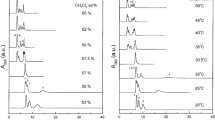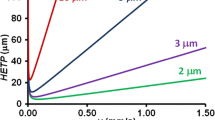Abstract
Liquid chromatography under critical conditions (LCCC) allows the separation of block copolymers from the corresponding homopolymers as well as the separation of homopolymers according to their functionality. At the transition of exclusion and adsorption mode, the polymer chain becomes “chromatographically invisible,” and thus a separation according to other structural units can be achieved. In the case of block copolymers this situation can be utilized to detect and determine unwanted homopolymers. At critical conditions for the repeat unit, the other block may be eluted in the exclusion or the adsorption regime. In the first case, the block copolymer is eluted before the homopolymer, and its molar mass can be determined as in size-exclusion chromatography. In the second case, it is eluted later than the homopolymer, and the separation of the individual oligomers can be achieved. Advantages and limitations of different approaches in LCCC are discussed.

Application of LCCC in the characterization of polypropylene glycol and its block copolymers.










Similar content being viewed by others
References
Gorbunov AA, Solovyova LY, Skvortsov AM (1998) Polymer 39:697
Gorbunov AA, Skvortsov AM (1988) Vysokomol Soedin Ser A 30:895
Skvortsov AM, Gorbunov AA (1990) J Chromatogr 507:487
Belenkii BG, Gankina ES, Zgonnik VN et al (1992) J Chromatogr 609:355
Pasch H (1996) Macromol Symp 110:107
Malik MI, Trathnigg B, Kappe CO (2008) Eur Polym J 44:144–154
Malik MI, Trathnigg B, Kappe CO (2007) Macromol Chem Phys 208:2510
Pasch H, Zammert I (1994) J Liq Chromatogr 17:3091
Gorshkov AV, Much H, Becker H et al (1990) J Chromatogr 523:91
Skvortsov AM, Gorbunov AA, Berek D et al (1998) Polymer 39:423
Malik MI, Trathnigg B, Kappe CO (2008) Eur Polym J. doi:10.1016/j.eurpolymj.2008.11.035
Piao L, Dai Z, Deng M et al (2003) Polymer 44:2025
Tirelli N, Lutolf MP, Napoli A et al (2002) Rev Mol Biotechnol 90:3
Lee JH, Lee HB, Andrade JD (1995) Progr Polym Sci 20:1043
Sundarrajan S, Surianarayanan M, Srinivasan KSV et al (2002) Macromolecules 35:3331
Kaal ER, Kurano M, Geißler M et al (2008) J Chromatogr A 1186:222
Terrier P, Buchmann W, Desmazieres B et al (2006) Anal Chem 78:1801
Guowei Wang JH (2008) J Polym Sci A Polym Chem 46:1136
Lu X-F, Liu Z-Q, Xing J-P et al (2008) Gaodeng Xuexiao Huaxue Xuebao 29:1267
Trathnigg B (1990) J Liq Chromatogr 13:1731
Trathnigg B (1991) J. Chromatogr 552:507
Trathnigg B, Feichtenhofer S, Kollroser M (1997) J Chromatogr A 786:75
Trathnigg B, Malik MI, Cuong NV et al (2008) J Chromatogr A 1207:122
Trathnigg B, Gorbunov AA (2001) J Chromatogr A 910:207
Trathnigg B (2001) J Chromatogr A 915:155
Pasch H, Augenstein M (1993) Makromol Chem Macromol Chem Phys 194:2533
Pasch H, Gallot Y, Trathnigg B (1993) Polymer 34:4986
Pasch H, Augenstein M, Trathnigg B (1994) Macromol Chem Phys 195:743
Pasch H, Brinkmann C, Much H et al (1992) J Chromatogr A 623:315
Batsberg W, Ndoni S, Trandum C et al (2004) Macromolecules 37:2965
Trathnigg B (2005) Polymer 46:9211
Trathnigg B, Gorbunov AA (2006) Macromol Symp 237:18
Rappel C, Trathnigg B, Gorbunov AA (2003) J Chromatogr A 984:29
Acknowledgements
M.I.M. and H.A. thank the Higher Education Commission (HEC) of Pakistan for a Ph.D. Scholarship. We also thank C. Oliver Kappe of CDLMC for his cooperation in the synthesis of most of the products used for this study.
Author information
Authors and Affiliations
Corresponding author
Rights and permissions
About this article
Cite this article
Malik, M.I., Ahmed, H. & Trathnigg, B. Liquid chromatography under critical conditions: Practical applications in the analysis of amphiphilic polymers. Anal Bioanal Chem 393, 1797–1804 (2009). https://doi.org/10.1007/s00216-008-2590-y
Received:
Revised:
Accepted:
Published:
Issue Date:
DOI: https://doi.org/10.1007/s00216-008-2590-y




